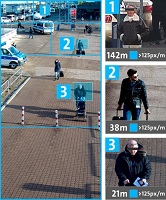For a long time, the ability to monitor large expanses seamlessly and in high resolution with video technology posed a challenge for which businesses could not find an economical solution. This problem was overcome successfully in 2011 with the Panomera camera technology developed by German manufacturer Dallmeier. Now, eight years after receiving a German patent, the technology has been awarded a European patent in recognition of its uniqueness.
In contrast to conventional technologies, which consist for example of a combination of megapixel and PTZ cameras or cameras with “multi-sensor” capabilities, Panomera multifocal-sensor systems capture all regions of an area continuously and in highest resolution because the images are stitched together intelligently in one camera system from as many as seven detail sensors plus an overall image sensor.
With this technology, the minimum resolution quality can be defined precisely for each region as early as the planning stage, thus ensuring that its data is usable in court or of a quality that permits analysis tasks. Based on this approach, areas or distances can be captured with a much smaller number of camera systems than is the case with conventional solutions.
During surveillance or observation itself, operators can zoom into any number of regions at the same time, while the high-resolution display of the overall event is maintained at all times. This unique Panomera technology has now been granted European Patent Number 2715692. Any number of zooms can be made with extremely high resolution in all detail regions of the overall event even after the fact, in the backup – an extremely important function in complex situations for example, or for successful forensic analysis.
At the same time, the Panomera cameras deliver “blanket coverage” in high image resolution in the truest sense of the word: In every partial region of the area to be monitored, the image quality does not fall below a defined minimum level. The decisive performance criterion here is the “resolution density”, which is defined in standard DIN EN 62676-4 with the unit “pixels per metre” (px/m).
For example, in order to be able to identify an unknown person, at least 250 px/m are required in the corresponding section of the image. This ensures that the video recordings are usable in court and is also particularly important for video analysis applications (e.g., object classification) for which consistent, precisely planned minimum data quality is essential. This is also especially important with regard to future AI-based analysis procedures, which are not even available on the market yet. Panomera offers the customer the ability to ensure corresponding data quality for purposes of protecting their investment with the camera sensor system of today.








